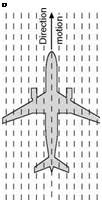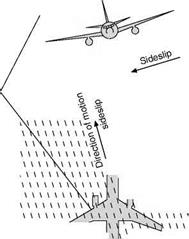High wing and low centre of gravity
If the wings are placed in a high position and the centre of gravity is correspondingly low, the lateral stability can be enhanced. When an aircraft sideslips, the lift on the lower wing becomes greater than that on the higher one. Furthermore, a small sideways drag force is introduced. In consequence, the resultant force on the wing will be in the general direction indicated in Fig. 9.7. You will see that this force does not now pass through the centre of gravity so there will be a small moment which will tend to roll the aircraft back to a level condition. This will occur even on a low-wing aircraft, but is more effective with a high wing because the moment arm is greater. For this reason a high-wing aircraft requires less dihedral than a low-wing type.
|
Wind due to sideslip |
Fig 9C Sweepback
An Airbus A330 showing the sweepback of the wings.
![]()




 |
Higher aspect ratio and more lift on this wing
\\\\\\ o, ^ *® %\\\\\
1A і M\\\\ \\\\\^ (-,\\\\ \\\\
|
\\\\ |
||
|
\ |
‘ ^ |
|
|
4 |
.a |
|
|
* |
||
|
‘ ‘ |
|
\\\\\u- ‘ t |
|
\\\\4| |
Direction of airflow due to sideslip
|
|
Fig 9.9 Effect of high fin on lateral stability
Sweepback and lateral stability
A considerable angle of sweepback (Fig. 9C) will in itself promote lateral stability, for, supposing the left wing to drop, as in the two previous cases, there will be a sideslip to the left and the left-hand wing will present, in effect, a higher aspect ratio than the right wing to the correcting airflow (Fig. 9.8). It will therefore receive more lift and, as before, recovery will take place after sideslip.
A forward sweep is sometimes used but this is not for reasons of stability (Fig. 9D, overleaf).













